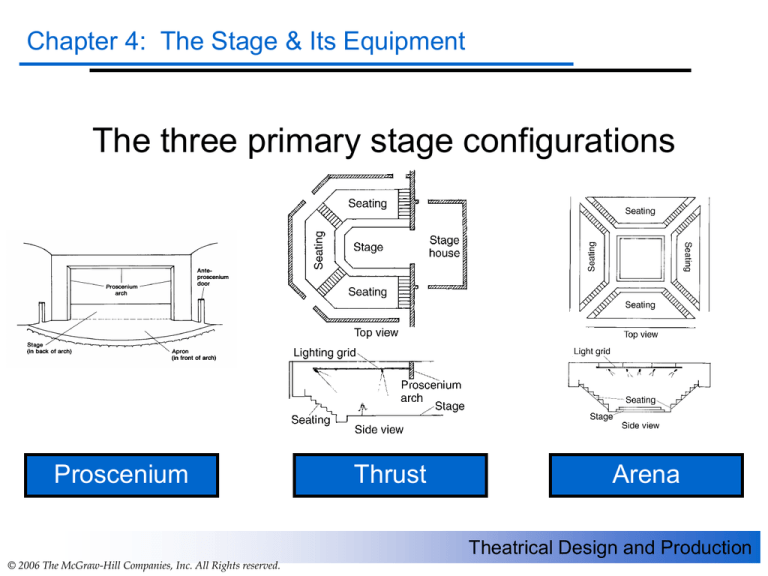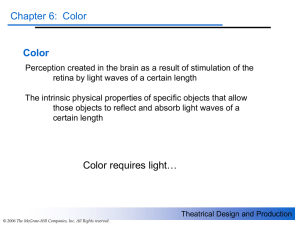
Chapter 4: The Stage & Its Equipment
The three primary stage configurations
Proscenium
Thrust
Arena
Theatrical Design and Production
© 2006 The McGraw-Hill Companies, Inc. All Rights reserved.
Chapter 4: The Stage & Its Equipment
Proscenium stage
Also known as the “picture frame
stage” because the spectators
observe the action through the
proscenium arch
Theatrical Design and Production
© 2006 The McGraw-Hill Companies, Inc. All Rights reserved.
Chapter 4: The Stage & Its Equipment
Proscenium stage
The proscenium arch is a direct
descendent of the proskenium and
skene of the Ancient Greek theatres
The arch separates the stage from
the auditorium
The arch can vary in both height and
width
The average theatre has an arch that is
18 to 22 feet high and 36 to 40 feet wide
Theatrical Design and Production
© 2006 The McGraw-Hill Companies, Inc. All Rights reserved.
Chapter 4: The Stage & Its Equipment
Proscenium stage
The playing area behind, or
upstage, of the arch is referred
to as the “stage”
A stage floor needs to be firm,
nonskid, paintable, resistant to
splintering and gouging, and
somewhat soundproof
While some productions utilize the space in front of the arch (known as the
“apron”, the primary playing space is typically behind the arch
Theatrical Design and Production
© 2006 The McGraw-Hill Companies, Inc. All Rights reserved.
Chapter 4: The Stage & Its Equipment
Proscenium stage
The Wings
The spaces on either side of
the stage are the wings
Wings are used for storage
of scenic elements, props,
and other equipment until
they are needed onstage
Theatrical Design and Production
© 2006 The McGraw-Hill Companies, Inc. All Rights reserved.
Chapter 4: The Stage & Its Equipment
Proscenium stage
The Apron
Also known as the forestage, the
apron is an extension of the stage
from the arch to the audience
It can vary in depth from a narrow 3
ft. to as much as 15 ft.
The apron also extends up to 15 ft.
beyond either side of the arch
Theatrical Design and Production
© 2006 The McGraw-Hill Companies, Inc. All Rights reserved.
Chapter 4: The Stage & Its Equipment
Proscenium stage
Orchestra Pit
Many proscenium theatres have an
orchestra pit, which is almost always
between the apron and the audience
It holds the pit band or orchestra during
performances that need live music
Pits are generally the full width of the
proscenium and can be 12 ft. wide
The pit needs to be deep enough so that
the orchestra will not obstruct the
audience’s view
Theatrical Design and Production
© 2006 The McGraw-Hill Companies, Inc. All Rights reserved.
Chapter 4: The Stage & Its Equipment
Proscenium stage
Orchestra Pit
Most theatres have found a way to
cover the pit when it is not in use;
some use removable floor boards
so that the apron space can be
used for non-musical productions
Some theatres use hydraulic lifts
to raise and lower the pit
Theatrical Design and Production
© 2006 The McGraw-Hill Companies, Inc. All Rights reserved.
Chapter 4: The Stage & Its Equipment
Proscenium stage equipment
Traps
Many theatres have “traps” cut into the
stage floor
Traps are removable sections which
provide access to the space beneath the
stage
The holes can be filled with stairs, an
elevator, a slide, or be left open
While traps are typically a feature of the
proscenium stage, they can be found in
thrust and arena stages as well
Theatrical Design and Production
© 2006 The McGraw-Hill Companies, Inc. All Rights reserved.
Chapter 4: The Stage & Its Equipment
Proscenium stage equipment
Revolve
Also called a turntable or
revolving stage, the revolve
provides a visually interesting
and efficient manner of shifting
scenery
Many theatres have revolves
built in to the stage floor
Les Miserables is a famous
example of a production that
uses the revolve in order to
simulate the characters “walking”
longer distances
Theatrical Design and Production
© 2006 The McGraw-Hill Companies, Inc. All Rights reserved.
Chapter 4: The Stage & Its Equipment
Proscenium stage
Fly Loft
The area directly over the stage is
called the fly loft
Referred to as “the flies”, it is usually
quite tall, at a minimum two and a
half times the height of the arch
The height allows scenery to be
raised out of sight of the audience
Theatrical Design and Production
© 2006 The McGraw-Hill Companies, Inc. All Rights reserved.
Chapter 4: The Stage & Its Equipment
Proscenium stage
Fly Systems:
Rope Set
Counterweight
Theatrical Design and Production
© 2006 The McGraw-Hill Companies, Inc. All Rights reserved.
Chapter 4: The Stage & Its Equipment
Proscenium stage
Rope Set
Operates like a rope and pulley, except
that it has three or more lines
The ropes support a batten
From the batten they run to the grid,
where they pass over loft blocks, which
lead them toward the side of the stage
house
At the edge of the grid, the lines pass
over the head block and then down to
the fly gallery where they are tied off at
the pin rail
Theatrical Design and Production
© 2006 The McGraw-Hill Companies, Inc. All Rights reserved.
Chapter 4: The Stage & Its Equipment
Batten: a thick wooden dowel or metal pipe from which are suspended
scenery and lighting instruments
Head block: a multisheave block with two or more pulley wheels, used
to change the direction of all the ropes or cables that support the batten
Fly gallery: the elevated walkway where the pin rail is located, usually
15 to 20 ft. above the stage floor
Loft blocks: a grooved pulley, mounted on top of the grid, used to
change the direction in which the rope or cable travels
Pin rail: a horizontal pipe or rail studded with belaying pins; the ropes of
the rope-set system are wrapped around the belaying pins to hold the
batten at a specific height
Stage house: the physical structure enclosing the area above the stage
and wings
Theatrical Design and Production
© 2006 The McGraw-Hill Companies, Inc. All Rights reserved.
Chapter 4: The Stage & Its Equipment
Proscenium stage
Counterweight System
The counterweight system works on the same
principle as the rope-set system and is much
safer
The support ropes and battens have been
replaced with steel cables
Instead of the cables being tied off at the pin
rail, they are secured to the top of a
counterweight arbor, or carriage
When the batten is lowered to the stage level,
the arbor raises to the level of the loading
platform just below the grid—thus allowing the
counterweights to be loaded safely
Theatrical Design and Production
© 2006 The McGraw-Hill Companies, Inc. All Rights reserved.
Chapter 4: The Stage & Its Equipment
Counterweight arbor: a metal cradle that holds the counterbalancing
weights used in a counterweight flying system
Loading platform: a walkway, suspended just below the grid, where
counterweights are loaded onto the arbor
Theatrical Design and Production
© 2006 The McGraw-Hill Companies, Inc. All Rights reserved.
Chapter 4: The Stage & Its Equipment
Proscenium stage
Motorized Flying Systems
Motorized rigging systems
are generally used to fly
heavy loads such as
orchestra shells, light
bridges, and so forth
There are three basic types
of motorized flying systems:
drum winches, line shaft
systems, and
counterweight-assisted
systems
Theatrical Design and Production
© 2006 The McGraw-Hill Companies, Inc. All Rights reserved.
Chapter 4: The Stage & Its Equipment
Proscenium stage
Motorized Flying Systems
Drum winches
Drum winches are used to
“dead lift” a load (lifting a load
without counterbalancing)
They are usually located to
one side of the stage
The cables are fed through a
series of blocks up to the grid
and down to the battens
Theatrical Design and Production
© 2006 The McGraw-Hill Companies, Inc. All Rights reserved.
Chapter 4: The Stage & Its Equipment
Proscenium stage
Motorized Flying Systems
Line Shaft
Counterweight-assisted
These motorized rigging systems
replace the operating line of a
hand-operated counterweight
system with a cable that is driven
by a drum winch
Line shaft rigging is another type of dead lift system
Mounted on the grid, these systems use a motor to drive a
rotating shaft equipped with multiple drums
Depending on the length of the batten, the shaft will normally have
between four and eight drums
Steel cable runs from each drum to support the batten
When the shaft is rotated, all the drums move simultaneously to
raise or lower the batten
Theatrical Design and Production
© 2006 The McGraw-Hill Companies, Inc. All Rights reserved.
Chapter 4: The Stage & Its Equipment
Proscenium stage
Stage Drapes
The proscenium stage uses
more drapery than the thrust
and arena
Although they have specific
functions, all stage drapes are
designed to hide or “mask”
backstage areas from the
spectators
Stage drapes are usually made
of black, light-absorbing material
such as heavyweight velour
Theatrical Design and Production
© 2006 The McGraw-Hill Companies, Inc. All Rights reserved.
Chapter 4: The Stage & Its Equipment
Proscenium stage
Stage Drapes
Grand Drape
The purpose of the grand drape (also
known as the main curtain or grand
rag) is to cover the opening of the
proscenium. In theatres with a fly loft,
this drape can usually be flown
(vertically) or traveled (horizontally)
Theatrical Design and Production
© 2006 The McGraw-Hill Companies, Inc. All Rights reserved.
Chapter 4: The Stage & Its Equipment
Proscenium stage
Stage Drapes
Grand Valance
Normally located just downstage of
the grand drape, the grand valance is
made of the same material as the
main curtain. It is much shorter,
however, usually only 8 to 12 ft. high.
It is used to mask the equipment and
scenery that are flown immediately
upstage of the proscenium
Theatrical Design and Production
© 2006 The McGraw-Hill Companies, Inc. All Rights reserved.
Chapter 4: The Stage & Its Equipment
Proscenium stage
Stage Drapes
False Proscenium
The false proscenium is
located immediately upstage
of the grand drape and
valance. It is normally
mounted on a rigid
frameword.
The “flat” structures of both
the hard teaser and
tormentors are covered with
thin plywood, which is then
covered with a velour-type
fabric. The primary purpose
of the false “pro” is to mask
Tormentor
the vertical flats
that form the side
elements of the
false proscenium
Hard teaser
the horizontal
element of the
false proscenium;
usually hung from
a counterweight
batten so that its
height can be
adjusted
Theatrical Design and Production
© 2006 The McGraw-Hill Companies, Inc. All Rights reserved.
Chapter 4: The Stage & Its Equipment
Show Portal
a false proscenium
that visually supports
the style and color
palette of a particular
production
Theatrical Design and Production
© 2006 The McGraw-Hill Companies, Inc. All Rights reserved.
Chapter 4: The Stage & Its Equipment
Proscenium stage
Stage Drapes
Legs and Borders
Legs are narrow, vertical
stage drapes that are used to
mask the sides of the stage
upstage of the arch. They are
made of the same material as
the other stage drapes.
Borders, also called teasers,
are short, wide, horizontal
draperies used to mask flies
Theatrical Design and Production
© 2006 The McGraw-Hill Companies, Inc. All Rights reserved.
Chapter 4: The Stage & Its Equipment
Proscenium stage
Stage Drapes
Sky Drop
Also known as the “sky tab”,
the sky drop is used to
simulate the sky. It is a large,
flat curtain usually made of
muslin or canvas. It is usually
hung on a batten as far
upstage as possible. After the
1960s, it became the lighting
designers job to make the offwhite muslin look like the sky
(rather than paint it blue)
Theatrical Design and Production
© 2006 The McGraw-Hill Companies, Inc. All Rights reserved.
Chapter 4: The Stage & Its Equipment
Proscenium stage
Stage Drapes
Cyclorama
Also known as the “cyc”
The cyclorama is an expansion
of the concept of the sky drop.
Sky drops cannot surround the
set with the illusion of vast
expanses of open sky.
The “fly cyc” is made from one
unbroken expanse of cloth.
Sometimes scrims are used in
conjunction with cycs and
skydrops
A scrim is a drop
made form
translucent or
transparent
material.
When light is shone
from the back onto
the scrim, the scrim
becomes
transparent.
When light is shone
on the front of the
scrim, it appears to
be opaque
Theatrical Design and Production
© 2006 The McGraw-Hill Companies, Inc. All Rights reserved.
Chapter 4: The Stage & Its Equipment
Thrust stage
The thrust stage is not a
new development.
From the Greeks
through the
Renaissance, audiences
gathered on three sides
of the playing stage to
watch theatrical
productions
Theatrical Design and Production
© 2006 The McGraw-Hill Companies, Inc. All Rights reserved.
Chapter 4: The Stage & Its Equipment
Thrust stage
The stage of the
thrust theatre
projects into and
is surround by the
audience, so tall
flats, drops, and
vertical masking
cannot be used
Theatrical Design and Production
© 2006 The McGraw-Hill Companies, Inc. All Rights reserved.
Chapter 4: The Stage & Its Equipment
Thrust stage
The lighting grid in
a thrust theatre is
usually suspended
over the entire stage.
Depending on the
design, the lighting
grid and instruments
can be hidden from
or in full view of the
audience.
Theatrical Design and Production
© 2006 The McGraw-Hill Companies, Inc. All Rights reserved.
Chapter 4: The Stage & Its Equipment
Thrust stage
Access to simpler grids is usually from a
rolling ladder or scaffold placed on the stage.
More complex grids frequently have access
from above to a series of catwalks and
walkways
Theatrical Design and Production
© 2006 The McGraw-Hill Companies, Inc. All Rights reserved.
Chapter 4: The Stage & Its Equipment
Thrust stage
Some thrust stages retain a vestigial
proscenium arch on the upstage wall as
well as a small backstage area.
Although battens are frequently “dead
hung” and unable to be raised or lowered,
some theatres have installed ratchet
winches, rope sets, or counterweight sets
to move the battens
Ratchet Winch
A device used
for hoisting with
a crank
attached to a
drum
Theatrical Design and Production
© 2006 The McGraw-Hill Companies, Inc. All Rights reserved.
Chapter 4: The Stage & Its Equipment
Arena stage
The arena stage is an even
more intimate actor-audience
theatre than the thrust.
With the audience
surrounding all sides of the
stage, they are much closer
to the action
Theatrical Design and Production
© 2006 The McGraw-Hill Companies, Inc. All Rights reserved.
Chapter 4: The Stage & Its Equipment
Arena stage
The scenery used on
an arena stage is
extremely minimal so
as not to block the
sightlines of the
audience.
Any design element
must be carefully and
accurately constructed
because the audience
is close enough to
notice
Theatrical Design and Production
© 2006 The McGraw-Hill Companies, Inc. All Rights reserved.
Chapter 4: The Stage & Its Equipment
Arena stage
As in the thrust stage,
the space above the
arena stage has a
lighting grid that
frequently covers not
only the stage, but also
the auditorium
Theatrical Design and Production
© 2006 The McGraw-Hill Companies, Inc. All Rights reserved.
Chapter 4: The Stage & Its Equipment
Black Box Theatres
Stage
Black box theatres
allow for flexible
staging.
Literally a blank,
black box, this space
can be transformed
into a proscenium,
thrust, or arena
stage
Stage
Stage
Theatrical Design and Production
© 2006 The McGraw-Hill Companies, Inc. All Rights reserved.
Chapter 4: The Stage & Its Equipment
“Found” Spaces
Found theatre
spaces are housed
in structures that
were originally
designed for some
other purpose.
Almost any and
every conceivable
space can be and
has been converted
into a theatre space
Supermarket
Office building
Lumberyard
Library
Restaurant
Just to name a few…
Theatrical Design and Production
© 2006 The McGraw-Hill Companies, Inc. All Rights reserved.










